|
|
|||
|
(Back to Preceding Week; on to Next Week) |
|
NOTE 1: We spent more than four weeks banding hummingbirds in Costa Rica in early 2009. The report below is for Week One. Accounts for Week Two and Week Three are also now posted, as is a Summary Report for 2009. We suggest you read the write-ups in order; they'll make more ense that way. Every week was different, so we hope you enjoy all the summaries. NOTE 2: A least four more nine-day Operation RubyThroat hummingbird expeditions are scheduled for January-March 2010 to Central America (Costa Rica and--for the first time--Guatemala and Belize). For more information see 2010 Hummingbird Banding Expeditions and contact EDUCATION.) HUMMINGBIRDS IN COSTA RICA: On 22 January 2009 we began our fifth year of studying Ruby-throated Hummingbirds in Costa Rica by departing Hilton Pond Center and jetting non-stop to San Jose, where we were met by Linda Carman--mother of our expert in-country guide and colleague Ernesto Carman Jr.
All text, maps, charts & photos © Hilton Pond Center After a brief chat with Ernesto and Ela we retired for our typical pleasant night at Finca Cristina. Next morning (23 January) we arose to an incredibly diverse dawn chorus and had a little spare time for photography while Ernie and Ernesto prepared the latter's car for our trip over to Guanacaste Province, across the volcanic ridge on Costa Rica's Pacific side. As coffee workers hurried about in misty rain we were privileged to watch an assortment of tropical birds visiting a platform feeder Ernesto had loaded that morning with ripe bananas. The parade was fascinating: male black and crimson Passerini's Tanager (above), Blue-gray Tanager, Baltimore Oriole, Clay-colored Robin, Great Kiskadee (below right), and even Hoffman's Woodpecker.
All text, maps, charts & photos © Hilton Pond Center Of equal interest was a brightly colored Variegated Squirrel (above left) that eventually dominated the feeder and had its fill of bananas. It seems North American homeowners aren't the only folks plagued by bushy-tailed tree rats at backyard feeders! After a couple of hours of morning work that included roof-mounting two new net pole carriers Ernie had invented, Ernesto's car was finally ready for the trip westward to Guanacaste. Accompanying us was Linda, Ernesto's mom, who planned to meet up with some friends for a mini-vacation weekend.
All text, maps, charts & photos © Hilton Pond Center The ride over via the Pan-American Highway was slower than usual--lots of buses, trucks, and accidents along the way added more than two hours to what on a good day can be a four-hour trip--but we finally passed through Liberia (the capital of Guanacaste Province) and followed the road up Rincon de la Vieja volcano to Buena Vista Lodge, home away from home during our Costa Rican hummingbird research. It was nearly 10 p.m., so we had to locate the night watchman who led us to our respective rooms. Linda found her two friends--former documentary film producers Cis Wilson and Mary Beth Yarrow--and Ernesto caught up with Guillermo Hernandez, who has been our helpful, dependable, and preferred driver for several Operation RubyThroat expeditions. This creatively moustached man is appropriately known to his peers as Bigotes, Costa Rican Spanish for "Whiskers." Bigotes took great pride in caring for his bus (above) and greeted everyone with thumbs-up and a salutary pura vida--the tico equivalent of "be happy," "that's cool," and/or "way to go." DAY ONE (24 Jan), ALPHA NINERS:
The purpose of our Omega Niner morning trip was two-fold. First we wanted to scout aloe fields to find the best place in which to conduct this year's hummingbird banding, and then we needed to get to the Liberia airport to meet the 14 North American citizen scientists who would be part of the Week One team--the "Alpha Niners"--our first group of 2009. We have to schedule and plan each midwinter hummingbird expedition a year in advance, so when we finally get to Guanacaste to rendezvous with our initial group there's always a certain amount of uncertainty and trepidation.
All text, maps, charts & photos © Hilton Pond Center Understandably, the advance team was eager to get to the aloe plantation on Day 1 (24 January) to see whether aloe blooms were peaking and if ruby-throats were frequenting flowers. We were surprised and chagrined to find MANY fewer aloe blossoms than expected--and needed--to attract hummingbirds the Alpha Niners were traveling thousands of miles to help study. (In the photo above, the only three flower stalks are on aloe plants to the right.) After exploring all the aloe fields in which we had banded ruby-throats in previous years, we concluded Aloe Vera Field #5 (AV5) probably was going to be the best location in which to work in 2009, even though it had far fewer flowers than in 2008. As might be expected, we were quite befuddled over why aloe was not flowering in fields that had been so prolific during Januaries past. We were also quite irritated to discover the local power company had chopped down that special creekside Jocote tree that yielded most of our 15 birds in Year One. And one other thing disturbed us: Three of the aloe fields we had used successfully in the past were now dotted with bright orange survey markers--a sure sign something strange was about to happen on our Cañas Dulces study site. Hmmmmm.
All text, maps, charts & photos © Hilton Pond Center As our semi-disappointing scouting trip ended, we sped off toward the Liberia airport and were pleased all 14 Alpha Niners landed safely and on time. Our furthest travelers were Tony & Irene Eyo from Alberta, Canada--as far northwest as ruby-throats ever breed--followed (mostly in alphabetical order) by Kay Freeman (Florida), Liz Layton (Washington DC), Ken & Mary Maxwell (Wisconsin), sisters Twyla Miranda & Laura Templeton (Texas), Jeannie Rippere (Virginia), Ann-Marie Rutkowski (New York), Joyce Story & Joy Wingersky (Arizona), Marcia Wade (Indiana), and Bob Wirtz (Georgia). After a quick lunch at the airport we boarded the bus and headed west toward Liberia, turning north up the Pan-American Highway toward Buena Vista Lodge. There our travelers checked into their rooms and soon headed toward the ever-popular El Mirador (lookout), where they were greeted by a spectacular late afternoon rainbow (above) and their first Costa Rica sunset. Then it was off to supper and an evening orientation meeting before bedding down for the night.
All text, maps, charts & photos © Hilton Pond Center DAY TWO (25 Jan), ALPHA NINERS: The Alpha Niners, eager to get into the field on their first full day in Costa Rica, rose before dawn for a hot breakfast and boarded the bus for a trip back down the volcanic slope of Rincon de la Vieja toward the Cañas Dulces aloe fields. To add an element of discovery, the advance group had not revealed results of the previous day's scouting trip, so we first took the Alpha Niners to AV1. On the walk into this site we saw quite a few bird species, including our first Ruby-throated Hummingbirds of the year. Some hummers were feeding on spidery white flowers (above) of a small tree new to our ever-growing list of Costa Rican plants from which we've seen ruby-throats taking nectar. We believe the tree to be a species of Bauhinia. (If you can verify our ID or provide a species name for this or any other tropical plant for which we seek identification, please contact us at RESEARCH.) After spending half an hour watching everything from hummingbirds to parakeets, the Alpha Niners finally got to the first aloe field (AV1) and found almost no blossoms, which caused them surprise and concern. However, confident in their ability to catch hummingbirds even after visiting four more sparsely blooming aloe patches, the participants ultimately agreed with the plan to erect mist nets in AV5--it being the field with the most (albeit meager) yellow flower stalks. Because AV5 was a field in which we had caught quite a few ruby-throats in years past, we were also hoping to encounter a few returns.
All text, maps, charts & photos © Hilton Pond Center Within AV5 (above) the Alpha Niners--being the first group of 2009--assumed the tedious tasks of re-establishing net lanes, putting ten or so mist nets on 10' metal poles, and erecting the nets. Our strategy was to unfurl a few nets among blooming aloe while placing most around the perimeter of AV5 between the field and a dense shrub layer that contained Lantana, Vervain, Turk's Cap Hibiscus, and other native hummingbird plants. Our hope was hummers flying from aloe to those plants would become ensnared in our nearly invisible nets hung in front of the dark native vegetation. All this set-up took a while--the Alpha Niners learning as they went--so on our first day in AV5 we had only about 90 minutes of net time. Nonetheless, the group caught one Ruby-throated Hummingbird--an adult female. With that success we shut down the nets at 11:30 a.m., stowed all the gear back in the bus, and headed back toward Buena Vista Lodge for lunch and a free afternoon.
All text, maps, charts & photos © Hilton Pond Center DAY THREE (26 Jan), ALPHA NINERS The Alpha Niners got an earlier start on the second day in AV5 by having all the nets open shortly after 7 a.m. There also was more feeding action among the aloe blossoms and by shutdown time at 11:15 a.m. seven adult ruby-throats had hit the nets--three males and four females. Mist nets are non-selective, of course, so one never knows what may get snared. Such was the case with one slender-billed bird not much larger than a hummer--our first-ever Long-billed Gnatwren (above and below).
All text, maps, charts & photos © Hilton Pond Center The diminutive gnatwren, Ramphocaenus melanurus, ranges from Mexico to Brazil; and, oddly enough, also occurs on Trinidad. The only member of its genus, it is in the Polioptilidae--the Gnatcatcher Family. (Formerly, gnatwrens were placed in Sylviidae, the Old World Warblers.) This social bird gleans among shrubs and forbs for small arthropods; the hook on the end of its slender bill surely makes short work of an insect or spider. The gnatwren's common name comes from its habit of holding its tail erect like a wren.
We were fortunate one thing our mist nets did NOT catch was the herd of hump-backed, curvy-horned Zebu (above) that wandered into AV5 on Day Two. Local farmers occasionally run cattle through our study site. We're not sure whether cows damage aloe with their hooves, but they do perform a service by munching on weeds that otherwise would need to be pulled by hand. Alpha Niners bravely placed themselves in front of the mist nets and shooed away any fierce-looking but docile Zebu that wandered too close. Other migratory Neotropical species we banded on 26 January were Indigo Bunting and Barn Swallow.
All text, maps, charts & photos © Hilton Pond Center DAY FOUR (27 Jan), ALPHA NINERS: Even though Alpha Niners got progressively more efficient by their third day in AV5, aloe flowers and hummers were still more scarce that anyone wanted. Four hours of running nets yielded just four adult ruby-throats (two males, two females), but the brightest bird of the day was a male Painted Bunting (above) in breathtaking technicolor plumage. This species has a disjunct breeding population in the coastal Carolinas and northern Florida, with nesting much more common in the southcentral U.S., Texas, and the eastern half of Mexico. Painted Buntings are considered uncommon migrants in Costa Rica; nonetheless, we catch and band several every year in the aloe fields--much to the pleasure of our trip participants. With ruby-throat action really slow, we decided to shut the nets a little early and re-board the bus for our scheduled afternoon trip to Santa Rosa National Park, about 45 minutes to the northwest. Santa Rosa is a gemstone of the Costa Rica park system and the only one that truly showcases the tropical dry forest that was once the dominant ecosystem of Guanacaste Province. Relatively few visitors to Costa Rica ever see the unique attributes of the tropical dry forest, opting instead to spend time in the lush, green growth of the tropical rain forest. The dry forest has two distinct components: Deciduous areas in which shrubs and trees lose their leaves during the dry season; and evergreen areas where woody plants retain their leaves throughout the year. Evergreen dry forests are usually in riparian locales with more soil moisture. Santa Rosa has both evergreen and deciduous woodlands, and each has its own special assortment of flora and fauna.
All text, maps, charts & photos © Hilton Pond Center After exploring natural and cultural history at Santa Rosa, the Alpha Niners headed toward Junquillal Beach and what they hoped would be a refreshing dip in the Pacific Ocean. Unfortunately, we arrived to find the beach covered by at least two species of small, brown jellyfish (above)--some of which mildly but nonetheless painfully stung the photographer on both feet as he tried to get photos of them in the surf. (Note to self: No more wading when jellyfish are present.) Interestingly, none of the usual Brown Pelicans and Magnificent Frigatebirds were present above or beyond the beach. We wondered if the invasion of stinging jellyfish was keeping away these avian fishermen.
All text, maps, charts & photos © Hilton Pond Center DAY FIVE (28 Jan), ALPHA NINERS: For the first time, in 2009 we expanded each "week" in Costa Rica to nine days. The first and last were travel days, while Days 2-4 and 6-8 were work days on which we visited aloe fields to capture and watch ruby-throats and make observations about hummingbird flowers. This allowed Day 5 to be an off-day--we called it "Hump Day" because it was the middle of the nine-day period--when participants could sleep in a little, relax, and make full use of recreational amenities at Buena Vista Lodge. Some folks visited the Serpentarium, others tried the Water Slide or Canopy Zip Line, and almost everyone visited the volcanic spa--some via horseback. One of the best aspects of the spa is getting smothered in hot volcanic mud before getting it squirted off and relaxing in thermal pools. Marcia Wade (above)--our official "jungle queen" from Muncie IN--was one of the Alpha Niners' most elegant "mudders." The Lodge is some distance from our study site at Cañas Dulces--the one-way bus ride takes about 45 minutes every morning--but it's worth the trip because of the scenic beauty and other opportunities offered at Buena Vista. Besides, as we ride down and up the mountain in our air conditioned bus each day we get to see all sorts of birds and other wildlife along the way! DAY SIX (29 Jan), ALPHA NINERS: When we returned to Cañas Dulces for our fourth day in the field we encountered a nightmare. Bad enough cattle had wandered through the site earlier that week, but on 29 January we got to AV5 and found aloe workers cutting down forbs and shrubs surrounding the area (see remains above).
All text, maps, charts & photos © Hilton Pond Center It was useless to erect nets that day in AV5, so the Alpha Niners hand-carried all our banding gear 500 yards back to AV3 as fast as we could go. AV3 was a productive field in Years Two through Four and, in fact, was the site where we had our first returns of Ruby-throated Hummingbirds from a preceding year. Those three birds were the first-ever evidence at least some ruby-throats show site fidelity on their wintering grounds in the Neotropics just as they do within their breeding range in North America. Unfortunately, AV3 had few aloe flowers AND the edges apparently had been cut some days earlier by the machete-wielders, but we didn't have much choice if we wanted to catch any hummers that day. The Alpha Niners rallied to the challenge, re-established net lanes we had used during previous seasons in AV3 (above), and managed to capture five RTHU--all adult females.
All text, maps, charts & photos © Hilton Pond Center DAY SEVEN (30 Jan), ALPHA NINERS: Next morning we returned to AV3 and set nets in the same lanes as the day before. The day was extremely slow and, for the first time we got skunked: No Ruby-throated Hummingbirds at all in four-and-a-half hours of work. Nontheless, the Alpha Niners got to spend quite a bit of time observing the behavior of free-flying ruby-throats and other bird species. We DID manage to catch two other male hummers--an Emerald Hummingbird and a Green-breasted Mango in heavy throat molt (above); the developing feathers of the latter are said to be "in quill." That day we also ran into Franklin, the local tico who manages the aloe fields. He confirmed our fears about those survey markers and the edge-cutting that had been going on, telling us that AV2, AV3, and part of AV4 were being broken up into lots to be sold as part of a subdivision. Such news did not bode well for the future of Operation RubyThroat in the Cañas Dulces aloe plantation.
All text, maps, charts & photos © Hilton Pond Center DAY EIGHT (31 Jan), ALPHA NINERS: The machete-men had completed their work, so after a no-catch second day in AV3 the Alpha Niners returned on 31 January to their original field and deployed mist nets in AV5. It was disheartening to see all the dead flora lying on the ground where several species of hummers had been feeding just a few days previously, but that's the risk one takes working at a site whose primary purpose is commercial agriculture. We took heart knowing most of the chopped-down plants would recover and send up new flowers, although not before our wintering ruby-throats (female above) had already flown north. Despite the defoliation, on their last day in the field the Alpha Niners caught three adult Ruby-throated Hummingbirds--two females and a male--bringing their total to 20 RTHU for six days of effort. (See Figure 1 below for totals.) Considering how our best-laid plans went awry due to survey work and edge-cutting, this was an admirable accomplishment by the Alpha Niners. Among other things they exceeded the 15 birds caught by the Pioneers and the New Wave during two weeks back in 2004-05. The other migratory Neotropical species we banded on 31 January was a Painted Bunting. (Click on image above to open a larger photo in a new browser window) DAY NINE (1 Feb), ALPHA NINERS: On Day Nine the Alpha Niners (above) slept in a little but got up early enough to finish packing, eat breakfast, sprint around Buena Vista Lodge for some last-minute photos, board the bus, and settle in for their final scenic ride down the mountain toward Liberia. En route to the airport the group listened to trip compiler Irene Eyo read the official list of birds observed during the week--a respectable total of 85 species either seen or heard by at least two people. At the airport folks paid their exit tax, got in a few final hugs, and made their way to their respective checkout counters before boarding afternoon flights back home, satisfied they had been productive Alpha Niners without whose help Operation RubyThroat would not be nearly as successful in studying hummingbirds in Costa Rica. We are ever-grateful for their time, their ideas, and especially their hard work in the hot, sunny aloe fields of Guanacaste Province. NOTE: Please scroll down for a summary of results from Week One, a scrapbook of Alpha Niner photos, and a postscript about an amazing discovery made by trip leaders AFTER the Alpha Niners left for home. (You might like the photos, but the postscript contains some truly amazing information.) All text, maps, charts & photos © Hilton Pond Center
All text, maps, charts & photos © Hilton Pond Center ALPHA NINERS GROUP (Week One) RESULTS During six days of erecting and running mist nets--Tony Eyo totes the all-important mallet (above)--the Alpha Niners in late January 2009 captured 20 Ruby-throated Hummingbirds (see Table 1 below), all of which we classified as "adults." This means there were no partially gorgeted males that would have been Second-Year (juvenile) birds that hatched out in 2008. Some females we caught could have been Second-Year, but because of difficulties in accurately ageing white-throated females we grouped them all as After-Hatch-Year, i.e., they hatched at least in 2008 but could have been older. Several females had distinctly brown forehead feathers being replaced by adult-looking metallic green plumage. We strongly suspect these were Second-Year birds and took extensive notes about them; recaptures of some of these RTHU in later years may allow us to make a more definitive estimate of their ages.
We should point out that all Ruby-throated Hummingbirds we capture at Cañas Dulces get a uniquely numbered aluminum leg band, but we also mark each bird with a line of temporary blue dye (above left). This allows us to tell whether banded birds remain on the study site after banding, which they often do. Although the dye usually wears off after a few weeks in the tropical sun, there is slight possibility one of our color-marked ruby-throats could be seen at a feeder in the U.S. early this spring. As shown in Table 1 (below), during Week One female RTHU outnumbered males by more than two-to-one, although the relatively small sample size of 20 birds might be misleading in this regard.
All text, maps, charts & photos © Hilton Pond Center ALPHA NINERS SCRAPBOOK We hope you'll enjoy the following images of people, places, plants, and wildlife, taken during Week One of our 2009 hummingbird banding expeditions to Costa Rica.
All text, maps, charts & photos © Hilton Pond Center A recently fledged family of Striped-headed Sparrows hangs out in their preferred habitat: A weedy old field nera Buena Vista Lodge.
All text, maps, charts & photos © Hilton Pond Center The one-inch-long unripe fruit of the Jocote tree, Spondias purpurea. Ticos and ticas eat the green fruit with salt. (Note the tiny purple-red flowers that make nectar eaten by Ruby-throated Hummingbirds.)
All text, maps, charts & photos © Hilton Pond Center These red, tubular, unidentified blossoms--which we believe to be on a plant classified in the Scrophulariaceae--was visited by Ruby-throated Hummingbirds along Guanacaste roadsides.
All text, maps, charts & photos © Hilton Pond Center In silhouette, this unidentified 12-inch, long-tailed anole-like lizard was seen frequently in the dry forest of Guanacaste Province, Costa Rica.
All text, maps, charts & photos © Hilton Pond Center The group meal at a Chinese restaurant in Liberia was a big hit with Alpha Niners--especially the grande Red Snappers that hung off both ends of the platters.
All text, maps, charts & photos © Hilton Pond Center A late afternoon shot of the black-billed, black-eyed, black-bodied Melodious Blackbird, a Mexican species not recorded in Costa Rica until 1987 but now found throughout the country.
All text, maps, charts & photos © Hilton Pond Center Limbs of big, mature trees in the dry forest at Santa Rosa National Park are often loaded with epiphytes: Orchids (above), cacti, ferns, mosses, lichens, etc.
All text, maps, charts & photos © Hilton Pond Center The Alpha Niners depart their cabins and load the bus in preparation for their final trip down the mountain to the Liberia airport--far in the distance.
All text, maps, charts & photos © Hilton Pond Center One of the nicest things about Buena Vista Lodge is it sits 2,400 feet up the side of a volcano and faces west, all the better to view outstanding sunsets over the distant Pacific Ocean. There's a great one every night.
All text, maps, charts & photos © Hilton Pond Center At the end of the Alpha Niners' Ruby-throated Hummingbird expedition to Costa Rica, original versions of this lovely water-color card (above)--created by sisters Twyla Miranda and Laura Templeton--were given to expert guide Ernesto Carman Jr., driver Guillermo "Whiskers" Hernandez, and trip leader Bill Hilton Jr. We each will cherish our card as reminder of all the Alpha Niners and their conscientious hard work in the aloe fields of Guanacaste Province. POSTSCRIPT FOR WEEK ONE: Upon parting with the Alpha Niners at the airport, the Omega Niners (Hilton and Carman) went into Liberia for lunch and then began a new scouting mission. Because we'd found few flowers in the aloe fields at Cañas Dulces AND had to contend with the cutting of native edge plants in AV3, AV4, and AV5, we were looking for other potential study sites before the Beta Niners arrived two days later. We knew of one other aloe plantation right on the Pan-American Highway about ten miles south of Liberia and, in fact, had stopped in previous years to scope it out. We had seen a few ruby-throats feeding there and had even asked the security guard in 2008 whether it might be possible to drive through to investigate further. We never were able to link up with and get permission from the finca manager, however, and this year were surprised to learn the plantation was no longer harvesting aloe. It was our understanding this farm belonged to Carrington Laboratories--which operated an aloe processing plant just south of Liberia--but this year were told the farm actually was owned by someone else. (Blame it on language barriers!) From this southernmost finca we drove back toward Liberia and stopped at Carrington's processing plant, which was locked up tight. A guard finally came to the gate and said the plant was closed and would not be opening anytime soon. We found all this to be suspicious--Carrington was a major employer in Liberia--so we decided to take a road that appeared to go behind the plant, hoping we could gain insight into what was going on with the local aloe industry. The unnamed road went west between two small residential compounds. When it eventually dead-ended several hundred yards from the Carrington plant we hopped out with our binoculars and walked along a narrow trail that curved back to the southeast. What we saw next was so unexpected it's hard to explain our thoughts and emotions: Unfolding in front of us, right behind the Carrington processing plant, was the biggest acreage of aloe we had ever seen--perhaps two hundred acres, maybe more--and every single plant was in full bloom! What a far cry this was from the sparsely flowered fields at Cañas Dulces.
We were stunned by the panorama, reminiscent of photos we'd seen of vast fields of tulips blooming in Holland . . . except these fields were all yellow with aloe--the very plant that served as a nectar source for Ruby-throated Hummingbirds up at our Cañas Dulces study site. We were dumbstruck by the view but were also exasperated we had not known these fields even existed. For four years we had believed the plantation ten miles to the south was Carrington's, when all along Carrington had its own expansive aloe finca right behind its processing plant--out of view from the main road. When we gazed out across the aloe we could see dozens of ruby-throats, to say nothing of the many Tennessee Warblers and orioles--both Baltimore and Orchard--that likewise were feeding on nectar. Barn Swallows chased insects above the field and Indigo Buntings and Blue Grosbeaks fed on seeds from weeds between the aloe, as did several native dove species. All in all, it was quite a scene; we just knew we'd found Hummingbird Heaven. Carrington's aloe was on perfectly flat land surrounded on the northwest side where we stood by a long, linear mound about ten feet high. Atop the mound was a barbed wire fence--complete with signs saying Prohibido el paso ("No Trespassing")--and on our side of the fence was a deep ditch that carried water away from the fields during rainy season. Even closer to us on our side of this ditch was another linear mound the same height as the one bearing the fence, and when we stood on it the ruby-throats flew right past us at eye level when they left the big aloe field. We surmised this outer mound--which we later learned was on public property--would be a perfect place to try some mist nets the following day, which is exactly what we did. With visions of Carrington's aloe plantation filling our dreams we Omega Niners could hardly sleep that night, and regretted the next day (2 February, Groundhog Day) we had several logistical matters to attend to before we could hightail it down the mountain to run some test nets on the outer mound. To make a long story short, by 11 a.m. we finally got to the Carrington perimeter site--by now called "CP1"--set up four nets, and within four-and-a-half hours had captured and banded 20 ruby-throats! Hummingbird Heaven, indeed!
Twenty was as many RTHU as we'd been able to band in all six field days up at Cañas Dulces with the Alpha Niners--thanks in part to all the disruptions; oddly, we captured 19 females but only one adult male. With this kind of success it was a no-brainer that after the Beta Niners arrived on 3 February we'd be spending our mornings at Carrington. (The Beta Niners' efforts in CP1 are the subject of the next installment of "This Week at Hilton Pond.") Other migratory Neotropical species banded on 2 February: Rose-breasted Grosbeak. NOTE: A least four more nine-day Operation RubyThroat hummingbird expeditions are scheduled for January-March 2010 to Central America (Costa Rica and--for the first time--Guatemala and Belize). For more information see 2010 Tropical Hummingbird Banding Expeditions and contact EDUCATION.)
Comments or questions about this week's installment?
Thanks to the following fine folks for recent gifts in support of Hilton Pond Center for Piedmont Natural History and/or Operation RubyThroat: The Hummingbird Project. Your tax-deductible contributions allow us to continue writing, photographing, and sharing "This Week at Hilton Pond." (Please see Support if you'd like to make a gift of your own. You can also contribute by ordering an Operation RubyThroat T-shirt.)
"This Week at Hilton Pond" is written & photographed You may wish to consult our Index of all nature topics covered since February 2000. You can also use our on-line Hilton Pond Search Engine at the bottom of this page. For a free, non-fattening, on-line subscription to |
|
Make direct donations on-line via
Network for Good: |
|
|
Use your PayPal account
to make direct donations: |
|
|
If you like to shop on-line, you please become a member of iGive, through which more than 750 on-line stores from Barnes & Noble to Lands' End will donate a percentage of your purchase price in support of Hilton Pond Center and Operation RubyThroat. For every new member who signs up and makes an on-line purchase iGive will donate an ADDITIONAL $5 to the Center. Please sign up by going to the iGive Web site; more than 200 members have signed up to help. It's a painless, important way for YOU to support our on-going work in conservation, education, and research. |
|
|
SPECIES BANDED THIS WEEK: * = New species for 2009 WEEKLY BANDING TOTAL 2 species 11 individuals YEARLY BANDING TOTAL (2009) 11 species 293 individuals 28-YEAR BANDING GRAND TOTAL (since 28 June 1982) 124 species 52,175 individuals
|
OTHER NATURE NOTES OF INTEREST All text & photos © Hilton Pond Center
|
|
|
|
(Back to Preceding Week; on to Next Week) Up to Top of Page Back to This Week at Hilton Pond Center Current Weather Conditions at Hilton Pond Center |
 You can also post questions for The Piedmont Naturalist |
Join the |
Search Engine for |
|
|
Rent Movies Online

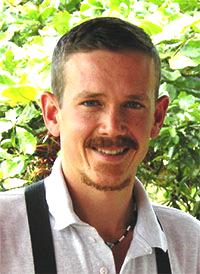 Ernesto (right) was out finishing up a 14-day private crosscountry tour for two British birders and wasn't due to return until that night, so Linda picked us up at the airport and took us along while delivering world-renowned coffee produced at Finca Cristina--the Carman family's environmentally sensitive, fully organic, shade-grown coffee farm near Paraiso. We got to the finca about dusk to be greeted by Ernie Carman Sr., Linda's husband. A few hours later Ernesto showed up with his long-time-girlfriend-now-fiance, Elaida "Ela" Villanueva Mayorga, a bright and beautiful Costa Rican Indian woman who had participated in our very first Operation RubyThroat expedition to the Neotropics back in December 2004. Ela is a true tica--the nickname Costa Rican women proudly apply to themselves--and a knowledgeable naturalist who wants to earn a college degree in biology.
Ernesto (right) was out finishing up a 14-day private crosscountry tour for two British birders and wasn't due to return until that night, so Linda picked us up at the airport and took us along while delivering world-renowned coffee produced at Finca Cristina--the Carman family's environmentally sensitive, fully organic, shade-grown coffee farm near Paraiso. We got to the finca about dusk to be greeted by Ernie Carman Sr., Linda's husband. A few hours later Ernesto showed up with his long-time-girlfriend-now-fiance, Elaida "Ela" Villanueva Mayorga, a bright and beautiful Costa Rican Indian woman who had participated in our very first Operation RubyThroat expedition to the Neotropics back in December 2004. Ela is a true tica--the nickname Costa Rican women proudly apply to themselves--and a knowledgeable naturalist who wants to earn a college degree in biology.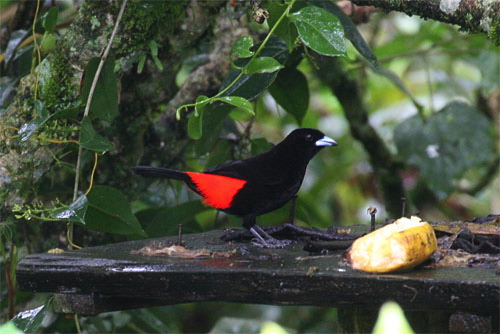
 ..
..
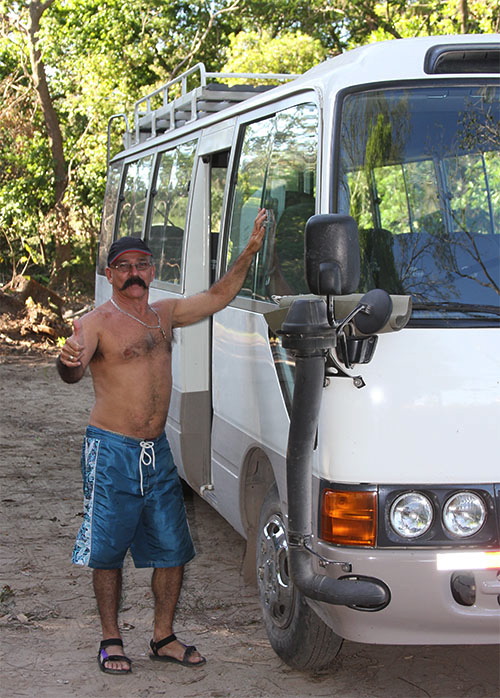
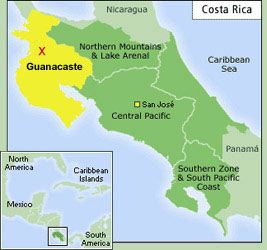 Next morning (24 January) the advance group (Ernesto and expedition leader Bill Hilton Jr., AKA the Omega Niners) ate a quick breakfast and traveled back down the mountain in Whisker's bus to Cañas Dulces, a small town near which an expansive Aloe Vera plantation serves as our primary ruby-throat study site in Guanacaste Province (see map at right). Guanacaste, along the Pacific coast, resembles west Texas and for half the year is drier, hotter, and less buggy than Costa Rica's Caribbean and Upland Regions most tourists visit. Of 50-plus hummingbird species found in Costa Rica, only about eight or ten occur in northern Guanacaste--where ruby-throats find grassy, treed savannahs and dry forest edges a good place to spend the winter. We believe November through February they are easily the most plentiful hummer species in the province. Althoughy nestled among the flower-rich dry forest, aloe fields are still a major attractant for ruby-throats that apparently find copious nectar from this non-native African succulent irresistible.
Next morning (24 January) the advance group (Ernesto and expedition leader Bill Hilton Jr., AKA the Omega Niners) ate a quick breakfast and traveled back down the mountain in Whisker's bus to Cañas Dulces, a small town near which an expansive Aloe Vera plantation serves as our primary ruby-throat study site in Guanacaste Province (see map at right). Guanacaste, along the Pacific coast, resembles west Texas and for half the year is drier, hotter, and less buggy than Costa Rica's Caribbean and Upland Regions most tourists visit. Of 50-plus hummingbird species found in Costa Rica, only about eight or ten occur in northern Guanacaste--where ruby-throats find grassy, treed savannahs and dry forest edges a good place to spend the winter. We believe November through February they are easily the most plentiful hummer species in the province. Althoughy nestled among the flower-rich dry forest, aloe fields are still a major attractant for ruby-throats that apparently find copious nectar from this non-native African succulent irresistible. We learned six years ago from Ernesto that Ruby-throated Hummingbirds frequented Guanacaste's aloe fields, but when we brought our first two groups to Costa Rica in December 2004 and January 2005 we found with considerable chagrin we had arrived too early; the aloe wasn't blooming, the hummers were dispersed throughout surrounding habitat, and we were able to band only 15 ruby-throats--most of which we trapped high up in a single Jocote tree at a bridge near the aloe (right). The following year (2006) we came in late February when aloe WAS in bloom and caught 51 RTHU in mist nets but apparently arrived too late to capture any adult males, which already had headed north toward breeding grounds in the U.S. and Canada. Since then we've settled on the last week in January and first two weeks of February as the optimal period for catching ruby-throats in Costa Rican aloe fields. Or so we thought.
We learned six years ago from Ernesto that Ruby-throated Hummingbirds frequented Guanacaste's aloe fields, but when we brought our first two groups to Costa Rica in December 2004 and January 2005 we found with considerable chagrin we had arrived too early; the aloe wasn't blooming, the hummers were dispersed throughout surrounding habitat, and we were able to band only 15 ruby-throats--most of which we trapped high up in a single Jocote tree at a bridge near the aloe (right). The following year (2006) we came in late February when aloe WAS in bloom and caught 51 RTHU in mist nets but apparently arrived too late to capture any adult males, which already had headed north toward breeding grounds in the U.S. and Canada. Since then we've settled on the last week in January and first two weeks of February as the optimal period for catching ruby-throats in Costa Rican aloe fields. Or so we thought.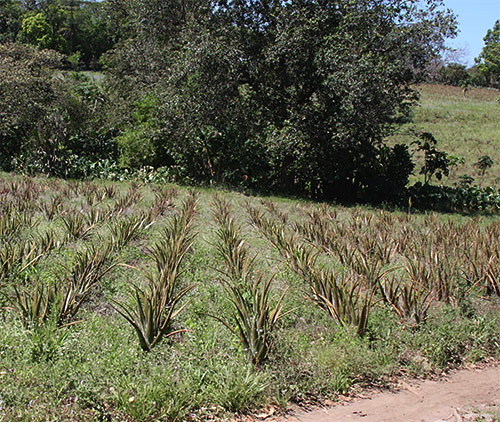
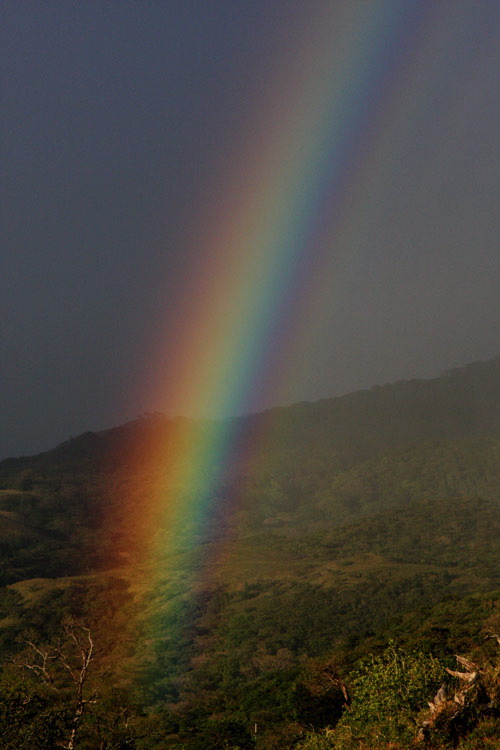

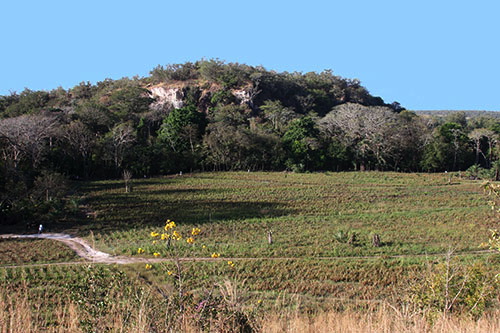

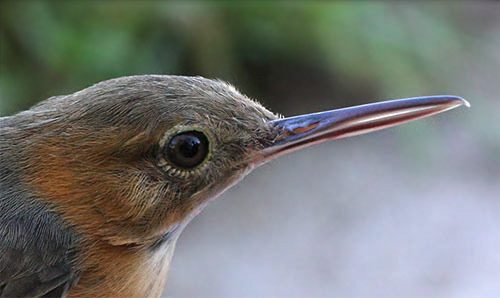
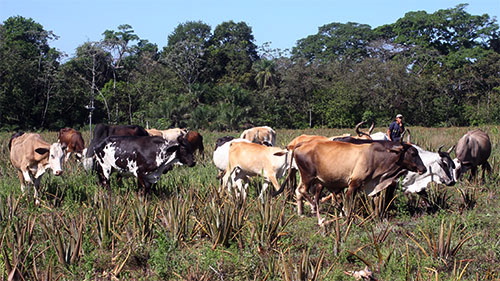

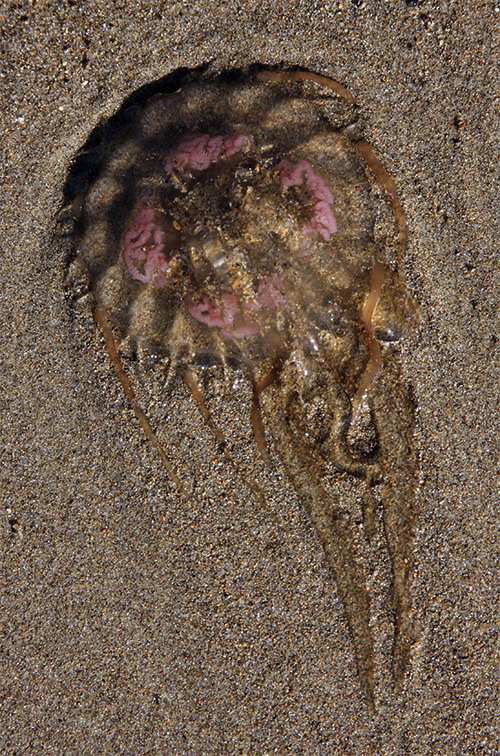
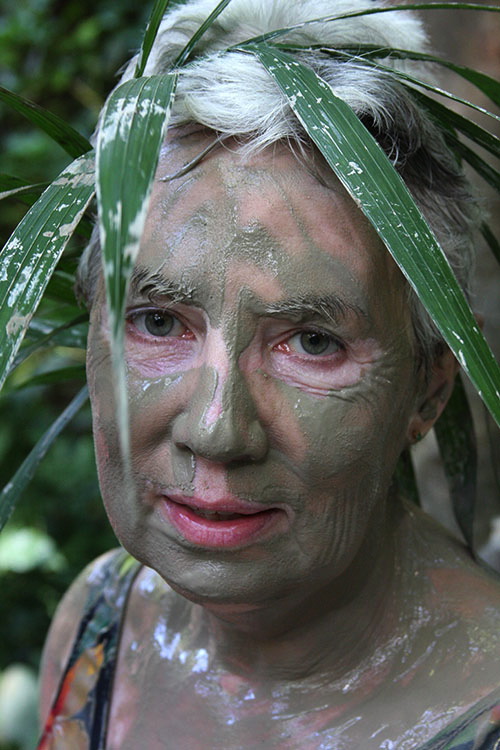
 The men were clearing all Turk's Cap Hibiscus (left), Lantana, and Vervain upon which hummers had been feeding when they weren't taking aloe nectar; in essence, they were clear-cutting our carefully selected net lanes--all in the name of making the aloe fields "look better." It was then we understood the probable purpose of those survey markers the advance team had seen when scouting the area before the Alpha Niners arrived: The aloe fields were about to be sold, and the workers were "dressing up" the area for prospective buyers. After five years of research, this prospect was disconcerting, to say the least.
The men were clearing all Turk's Cap Hibiscus (left), Lantana, and Vervain upon which hummers had been feeding when they weren't taking aloe nectar; in essence, they were clear-cutting our carefully selected net lanes--all in the name of making the aloe fields "look better." It was then we understood the probable purpose of those survey markers the advance team had seen when scouting the area before the Alpha Niners arrived: The aloe fields were about to be sold, and the workers were "dressing up" the area for prospective buyers. After five years of research, this prospect was disconcerting, to say the least.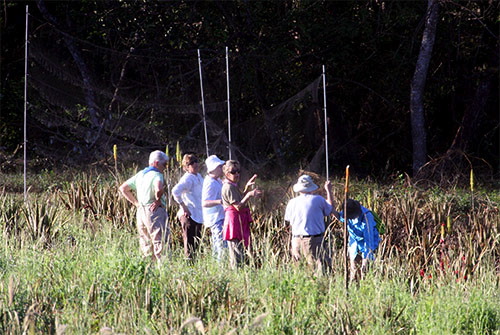


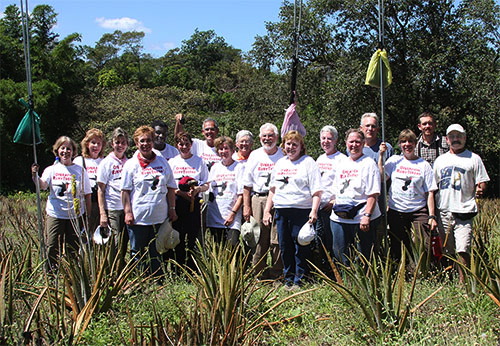
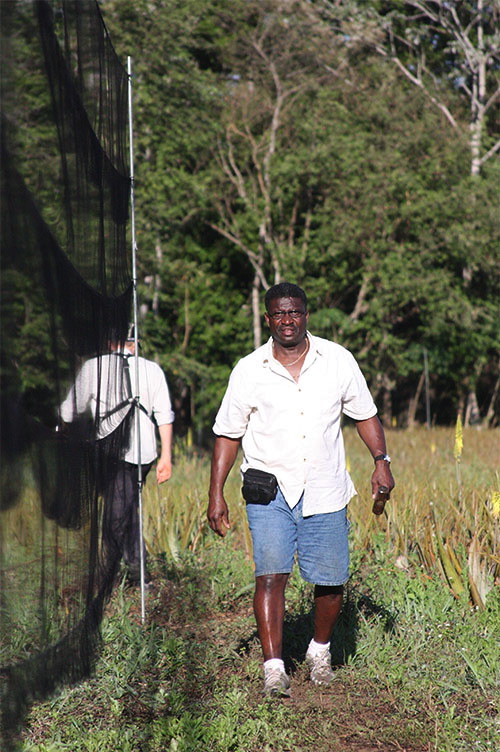
 Adult male RTHU--those with red throats--sometimes can be aged more specifically based by length of their primary feathers, AKA "wing chord." Juvenile ruby-throats leave the nest in North America and eventually fly to the Neotropics with wing chords of 40mm or more. When they molt all their plumage on the wintering grounds, young birds bring in adult wing feathers that are shorter--typically 35-39mm in males. Thus, a red-gorgetted male with old, faded feathers in the 35-39mm range must have hatched out not in 2008 but at least the year prior to that, hence the classification of After-Second-Year for fibe males captured by the Alpha Niners.
Adult male RTHU--those with red throats--sometimes can be aged more specifically based by length of their primary feathers, AKA "wing chord." Juvenile ruby-throats leave the nest in North America and eventually fly to the Neotropics with wing chords of 40mm or more. When they molt all their plumage on the wintering grounds, young birds bring in adult wing feathers that are shorter--typically 35-39mm in males. Thus, a red-gorgetted male with old, faded feathers in the 35-39mm range must have hatched out not in 2008 but at least the year prior to that, hence the classification of After-Second-Year for fibe males captured by the Alpha Niners.  One red-throated male going through wing molt and missing some of his primary feathers in 2009 gave a "false measurement" that was "too short" and was classified simply as After-Hatch-Year.
One red-throated male going through wing molt and missing some of his primary feathers in 2009 gave a "false measurement" that was "too short" and was classified simply as After-Hatch-Year.
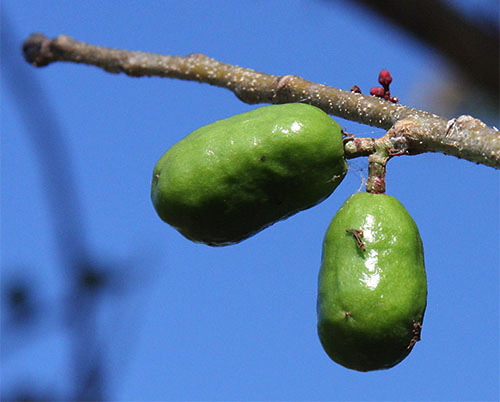
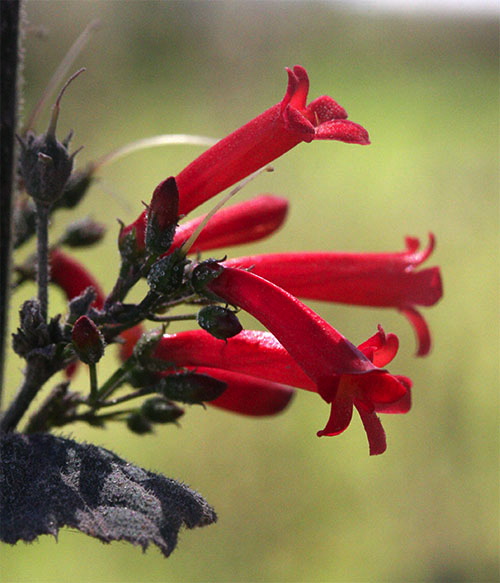
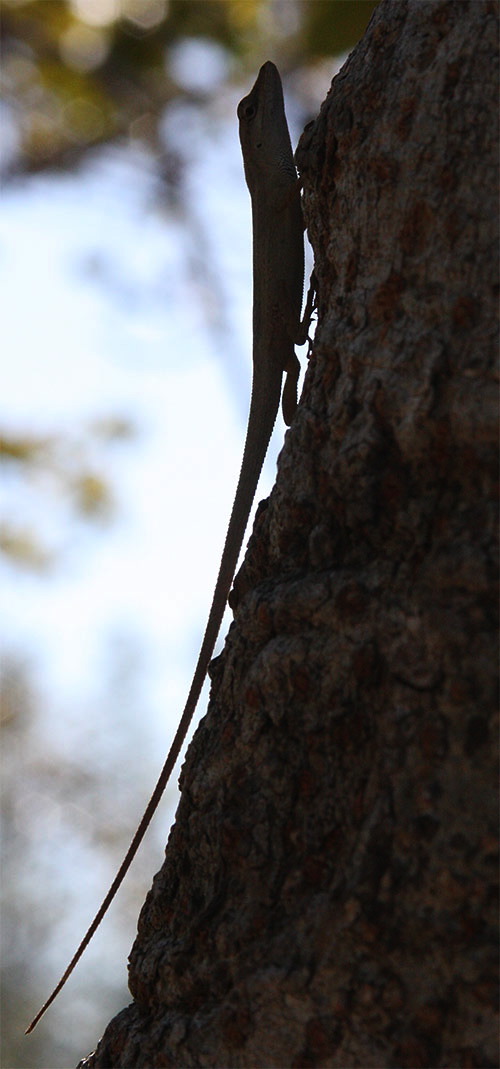

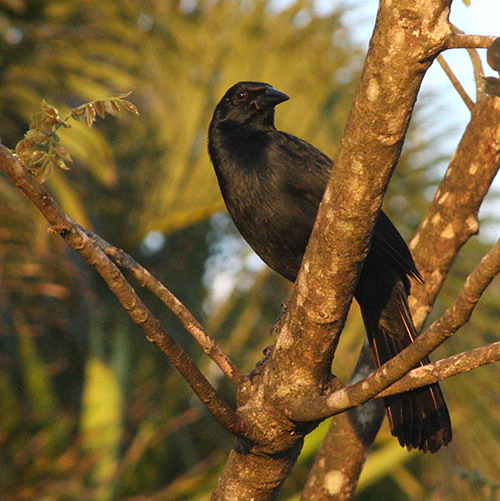
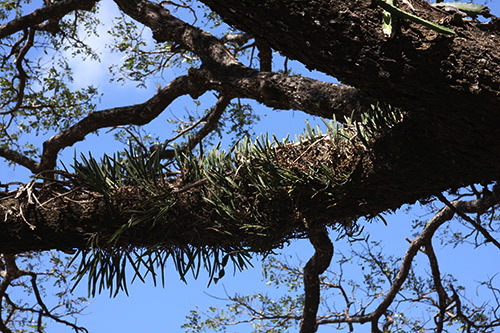
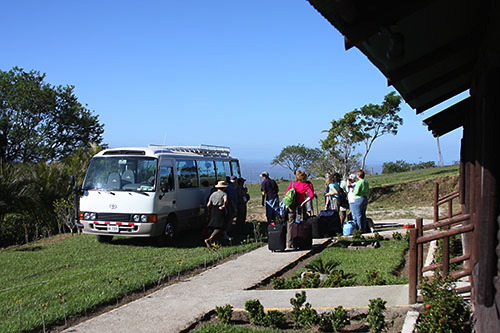
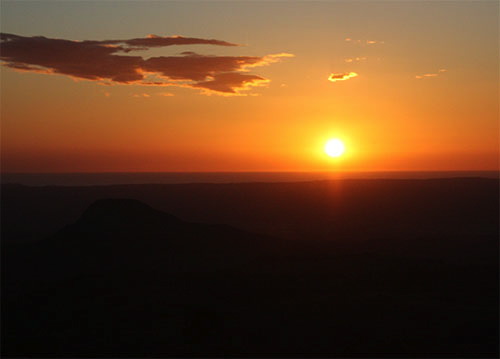
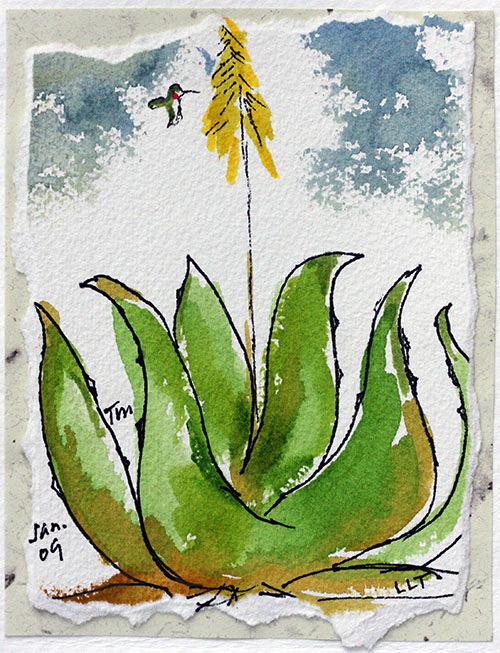
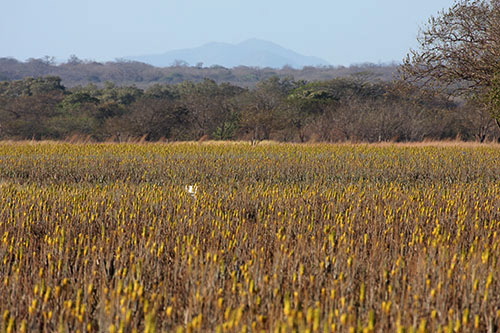


 Oct 15 to Mar 15:
Oct 15 to Mar 15: